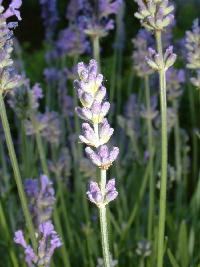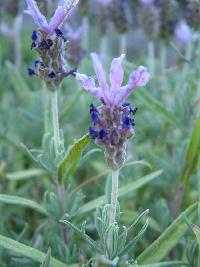Lavender
By Debs Cook

has strongly aromatic narrow, grey-green hairy leaves and dense spikes of flowers.
Varieties include Hidcote, Munstead, and Nana Alba.
History
Lavender has been used throughout the ages. The Romans introduced lavender and its uses into England and Europe. They used the flower heads in their communal baths not only for their fragrance but probably also as an antiseptic. The ancient Greeks are also thought to have used lavender for the treatment of throat infections and chest complaints.
In medieval times herbalists used lavender to prevent head lice. For many centuries lavender flowers have been tied into small bundles and placed into pillows or laundry to make them smell pleasant and keep bugs away.
Lavender has been prized for its wonderful perfume since Elizabethan times when it was used for sweetening washing water and disguising foul smells. The reverence for its perfume still continues today. During the Black Death (Plague) in 1665, lavender was hung in bunches, so its fragrance would cloak the foul smell of death and decay.
Folklore
Lavender has many old wives' tales associated with it. It has been seen as a symbol of distrust. It is also believed to provide protection, peace, and happiness. Lavender is reputed to help attract love and increase longevity. It is said that planting lavender around the house will help deter evil and protect the people within the household. Putting the flowers between the bed sheets will ensure that a couple will never quarrel.
Description

has winged bracts all along with its flower spikes.
Varieties include Kew Red, Fat Head, and Tickled Pink
All parts of the plant have the characteristic scent of lavender, there are varieties that are hardy, (for example Lavendula Angustifolia) and there are tender varieties (for example Lavandula x Christiana - Grappenhall).
Young growth is green and soft, whilst older stems are woody and vary between 20 - 30cm in length. The flowering stems are leafless and unbranched and rise high above the leaves up to 60cm in height. Lavender is available in a variety of colors, from the classic hues of lavender through to purple, lilac, blue, pink, and even white and cream.
There are many different kinds of lavender found in the UK, including English lavender (Lavendula Angustifolia) spike lavender (Lavandula latifolia), Lavandin (Lavandula x intermedia) which is a hybrid between English and spike lavender, French lavender (Lavandula dentata), and Spanish lavender - (Lavandula stoechas). French and Spanish lavender are often confused since English lavender is native to France and French lavender is native to Spain!
Growing
Lavender prefers a sunny dry spot. It will grow in slightly damp conditions but too much rain or watering, or high humidity, can cause disease and loss of the plant. Sandy soil is best. If you have a dry patch in your garden, this would be an ideal spot to grow lavender.

has toothed leaves, the flowers resemble those of the stoechas, although the bracts are not as pronounced and are woollier.
Varieties include Dusky Maiden, Ploughman's Blue, and Goodwin Creek Grey.
Plant the lavender slightly above ground level on a mound of soil. This will keep the foliage dry as well as enhance drainage. If you don't have a garden or your garden is too damp to successfully grow lavender, you can grow it in a pot. Use a peat substitute mix (say, coir based) with added perlite to help with drainage, ensure your compost provides excellent drainage, and has a slightly alkaline ph to keep your lavender happy.
Your lavender needs to have plenty of air circulating around it. If you plant the lavender in a mixed border or bed, make sure you surround it with a low-growing companion. Ideally, lavender plants should be spaced about 90cm apart.
Once established you can keep your lavender looking good for as long as possible by regularly pruning. Prune back all dead branches and growth that show signs of frost damage after winter. To do this, cut back to where you see new growth beginning to sprout. This may seem a little savage, but your plant will love you for it and will do better in the long run if you prune it on a regular basis. Lavender plants will eventually look tired and old, so it's best to replace the plants every few years.
Preserving

July is an excellent time to begin preserving your lavender. Fresh lavender flowers can be picked to make lavender water, tinctures, and oil and used in a wealth of culinary recipes. Lavender can also be dried for use in floral arrangements, making herbal sleep pillows and potpourri, and in a host of other uses. To harvest lavender for drying, it is best to choose stems that only have two or three opened flower buds, the rest will open during the drying process. Be sure to cut your lavender stems just after the dew is off of them. If you wait until later in the day, the plant will have lost its vital essential oils in the process of cooling itself down. It is, of course, these essential oils that give the lavender its wonderful aroma.
General Use
Lavender is a quintessential herb for most gardeners, whether they favor it for its herbal use or just for its scent and decorative properties. It's a perfect planting partner for roses and has the ability to lend itself to edging beds and borders or being a feature plant. It brings bees and butterflies into the garden as well as other beneficial insects, making it a gardener's friend. Lavender is used in the home for its sweet scent. It is used in beeswax polish, disinfectants, and potpourris. It is a popular oil for making toiletries such as soap and bath products, and for use in aromatherapy. Put inside drawers, wardrobes, and cupboards lavender to help deter moths.
Medicinal Use
Lavender is a wonderfully calming herb so it can help relieve stress and insomnia. It is an anti-spasmodic and anti-depressant, and also contains wonderful anti-bacterial properties. Made into creams it can soothe rheumatic pains and sore skin. As oil, it can be used neat to help relieve insect stings and sunburn. Lavender has antiseptic properties and is mildly sedative making it a natural painkiller. Rub the oil into the affected area to help soothe a headache. Make a dilution in sweet almond oil and use to massage externally onto a sore throat to help ease the discomfort.
Cosmetical Use
Lavender (Lavandula) oil is used to treat many skin conditions. It is an excellent skincare oil that soothes pain and discomfort. Lavandula is helpful for treating itchy skin, bruises, burns, and blemishes. It promotes circulation and encourages dermal cell growth.
Culinary Use
You can use lavender to make lavender sugar, jellies, ice cream, and vinegar. It can also be crystallized for use as a cake decoration. You can make a refreshing tea from the flowers mixed with lemon balm and lemon verbena.
My favorite recipe for using lavender is in my own Lavender and Lemon Biscuits (recipe below). I use fresh lavender flowers and leaves, but you can use dried if you prefer, or if that's all you have.
Recipe:
Lavender and Lemon Biscuits

Ingredients
- 100g Butter 50g Caster Sugar
- 175g Self Raising Flour
- 1 Tsp Lemon Zest
- 2 Tbsp Fresh, Chopped Lavender Leaves
- 1 Tbsp Lavender Flowers
Method
- Cream the butter and sugar together until light and fluffy.
- Add the flour, lemon zest, and lavender leaves and knead well until the mixture forms a dough. Gently roll out on a lightly floured board.
- Scatter the flowers over the rolled dough and lightly press in with the rolling pin.
- Cut into small rounds with a biscuit cutter.
- Place biscuits on a greased baking sheet and bake in a hot oven 450F/230C, gas mark 7 for 10-12 minutes until golden brown and firm to the touch.
- Remove at once and cool on a wire tray.
